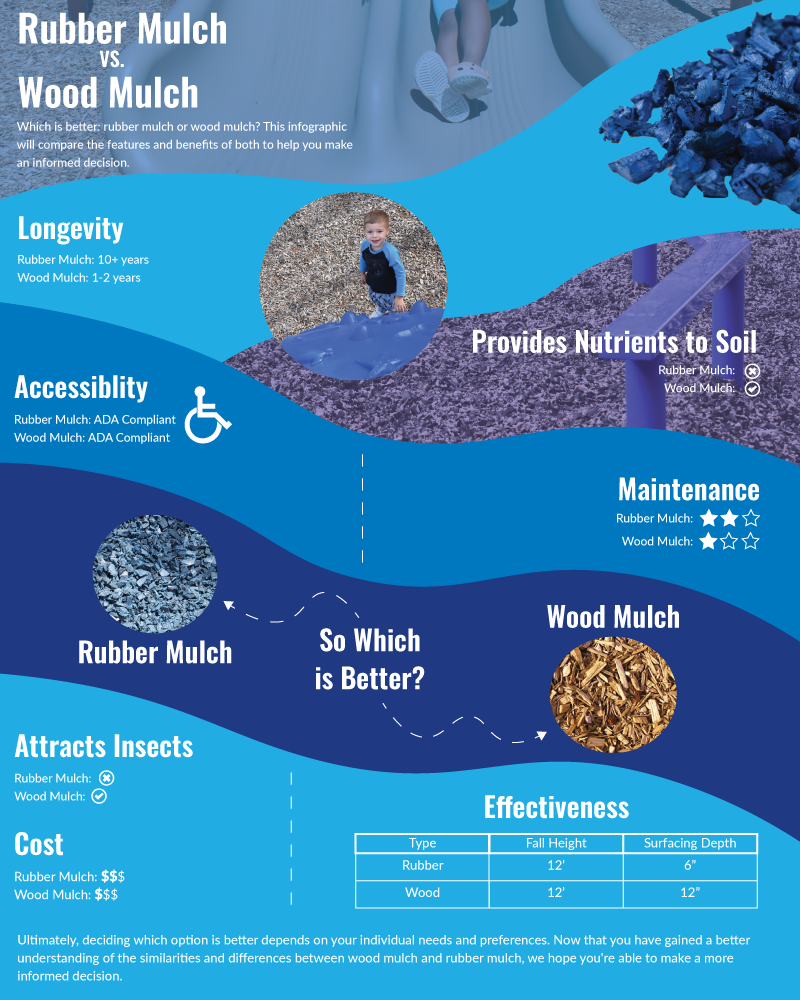Rubber Mulch vs Wood Mulch
Rubber Mulch or Wood Mulch: Which is Better for Landscaping and Playground Surfacing?
The choice between Rubber Mulch and Wood Mulch largely depends on the specific needs of your outdoor area. When properly maintained, both can be an aesthetically-pleasing addition to an outdoor space. Garden enthusiasts often prefer to use wood mulch, but when it comes to playground surfacing, many park and playground operators opt to use rubber mulch. No one surfacing material will satisfy every need of your playground, but picking the right one is easier when you know all the facts.
That said, it’s important to note that the type of wood mulch typically used for playground surfacing is different from that used in gardens. Engineered Wood Fiber mulch, or EWF mulch for short, is made from the wood of the tree, rather than the bark. Among other things, this means fewer slivers and better fall cushioning than bark mulch. Before delving too far into the two varieties of wood mulch, let’s take a look at how rubber and wood mulch differ.
Durability
Unlike its wood counterpart, rubber mulch won’t easily decompose or break down over time. This makes it ideal for playgrounds or other outdoor spaces in which safe, reliable surfacing material is needed. Meanwhile, wood mulch is an organic material, and as such, it’s affected by environmental factors such as sunlight and insects, which can cause it to wear down significantly faster than rubber mulch. Wood mulch also doesn’t retain its natural color for as long as rubber mulch does, potentially increasing the need to replace it more frequently.
Maintenance
Generally speaking, rubber mulch doesn’t need to be replenished or reapplied as often as wood mulch. This is because rubber mulch is more dense and durable, making it less prone to displacement by strong wind gusts and other environmental factors. On the other hand, wood mulch is significantly cheaper than rubber mulch, so even though it will need to be replenished around once a year, you’ll still pay a lesser upfront cost than you would for buying its rubber cousin.
Environmental Sustainability
Made from old rubber materials such as tires, rubber mulch is a sound option for those looking to reduce, reuse, and recycle. However, since rubber mulch isn’t an organic material like wood, it won’t provide the soil beneath it with the organic material it needs for flowers and vegetables to flourish. For this reason, wood mulch is often better suited for gardens and other areas where significant plant life exists. Additionally, gardeners will be happy to learn that wood mulch may help to curtail the emissions of greenhouse gasses (such as nitrous oxide) often produced by large gardens.
Accessibility
Whether for a playground or a walking path, proper surfacing material is a must. Compared with EWF mulch, rubber mulch as a playground surfacing option is easier to navigate for those with mobility impairments, particularly individuals who use wheelchairs, walkers, or canes. Its level surface and shock absorption make it an excellent choice when constructing an inclusive playground. EWF mulch, while shock absorbent at proper depths, doesn’t smooth as easily as rubber mulch, and can create obstructions for those in wheelchairs.
Conclusion
These are just a few of the key differences between rubber and wood mulch, and it’s important to keep in mind that they’re both useful in different contexts. Which type of mulch you should buy will ultimately depend on the needs of your outdoor space, as no one type is ideal for every type of environment. Get in touch with us to discuss the best playground surfacing solution for your outdoor space and ensure the safety and joy of children at play.
Find more about the author: Kim Hart

